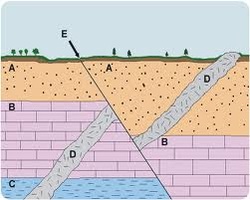- Dating Fossils – How Are Fossils Dated? - media-aid.com
- Relative Dating
- Geologic Age Dating Explained
Related questions What is the age of inclusions found in a rock relative to the rock in which they are found? What is the principle of cross-cutting relations and why is it important for relative dating?
Dating Fossils – How Are Fossils Dated? - media-aid.com
What forces can disturb relative dating? What is the law of superposition and how can it be used to relatively date rocks? What is meant by dating rocks relatively rather than absolutely? How can fossils be used to determine the relative ages of rock layers?

How does the law of crosscutting relationships help scientists determine the relative age of rocks? Are only sedimentary rocks used for relative age determination? When you complete this activity, you will be able to: The first card in the sequence has "Card 1, Set A" in the lower left-hand corner and represents the bottom of the sequence. If the letters "T" and "C" represent fossils in the oldest rock layer, they are the oldest fossils, or the first fossils formed in the past for this sequence of rock layers. Now, look for a card that has either a "T" or "C" written on it.
Since this card has a common letter with the first card, it must go on top of the "TC" card. The fossils represented by the letters on this card are "younger" than the "T" or "C" fossils on the "TC" card which represents fossils in the oldest rock layer. Sequence the remaining cards by using the same process.
When you finish, you should have a vertical stack of cards with the top card representing the youngest fossils of this rock sequence and the "TC" card at the bottom of the stack representing the oldest fossils. Starting with the top card, the letters should be in order from youngest to oldest. Return to top Procedure Set B: Each card represents a particular rock layer with a collection of fossils that are found in that particular rock stratum.
All of the fossils represented would be found in sedimentary rocks of marine origin. Figure 2-A gives some background information on the individual fossils. The letters on the other cards have no significance to the sequencing procedure and should be ignored at this time. Find a rock layer that has at least one of the fossils you found in the oldest rock layer. This rock layer would be younger as indicated by the appearance of new fossils in the rock stratum. Keep in mind that extinction is forever. Once an organism disappears from the sequence it cannot reappear later.
Use this information to sequence the cards in a vertical stack of fossils in rock strata. Arrange them from oldest to youngest with the oldest layer on the bottom and the youngest on top.
Relative Dating
This will enable your teacher to quickly check whether you have the correct sequence. Three-lobed body; burrowing, crawling, and swimming forms; extinct NAME: Many were large a few rare species were 5 feet in length ; crawling and swimming forms; extinct NAME: Primitive form of chordate; floating form with branched stalks; extinct NAME: Jellyfish relative with stony Cnidaria calcareous exoskeleton found in reef environments; extinct NAME: Pretty obvious that the dike came after the rocks it cuts through, right? With absolute age dating, you get a real age in actual years.
Based on the Rule of Superposition, certain organisms clearly lived before others, during certain geologic times. The narrower a range of time that an animal lived, the better it is as an index of a specific time. No bones about it, fossils are important age markers. But the most accurate forms of absolute age dating are radiometric methods. This method works because some unstable radioactive isotopes of some elements decay at a known rate into daughter products. This rate of decay is called a half-life.
Geologic Age Dating Explained
Half-life simply means the amount of time it takes for half of a remaining particular isotope to decay to a daughter product. Good discussion from the US Geological Survey: So geochronolgists just measure the ratio of the remaining parent atom to the amount of daughter and voila, they know how long the molecule has been hanging out decaying. There are a couple catches, of course.
Not all rocks have radioactive elements. Sedimentary rocks in particular are notoriously radioactive-free zones. So to date those, geologists look for layers like volcanic ash that might be sandwiched between the sedimentary layers, and that tend to have radioactive elements.
You might have noticed that many of the oldest age dates come from a mineral called zircon. Each radioactive isotope works best for particular applications.
